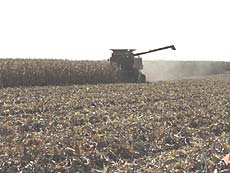|
Features,
Honors
& Awards, Ag
Announcements
Ag News Elsewhere
(fresh daily from the Web)
|
|
Features
|
|
Logan
County 4-H’ers
celebrate National 4-H Week
[OCT.
6, 2001] Logan
County 4-H’ers are joining nearly 7 million boys and girls
nationwide in the Oct. 7-13 observance of National 4-H Week.
|
|
In
Logan County, there are over 80 volunteer leaders working with more
than 300 4-H members. These volunteers are among the more than
500,000 leaders nationwide who each contributed about 220 hours of
service last year.
The
4-H program, conducted by the University of Illinois Extension, is
open to boys and girls ages 8-19, wherever they live. Activities are
conducted in the 3,150 counties of the United States, the District
of Columbia and six territories.
The
4-H thrives because of a unique partnership with the public and
private sectors, which contribute at the local, state and national
level. Not only does this partnership include financial support, but
also many business people volunteer their time and talents to boys
and girls. Support at the local level is received through the help
of many businesses, financial institutions, civic organizations and
service groups.
For
more information on how you can become involved in 4-H as a member
or volunteer leader, contact the Logan County Extension office at
732-8289. The 4-H program is open to all youth ages 8-19, regardless
of race, color or creed.
[News
release]
|


|
|
|
Nuisance
insect pests
[OCT.
6, 2001] With
fall definitely in the air, many of nature’s own are trying to
find shelter for the winter. This group would include crickets,
ants, spiders, ladybugs and elm leaf beetles. They are really
seeking warmth, and they don’t care if they are on a rock in the
sun or in your basement. Once in the home, you must decide whether
to use pesticides, the vacuum cleaner or tolerate them.
|
|
You
can save yourself a great deal of worry over the welfare of children
and pets by choosing a non-chemical course of action (the vacuum or
tolerance). Another option that keeps pesticides out of the house is
to spray a barrier of diazinon on the outside foundation of the
house.
Foundation
sprays can be reduced to following a five-step program to have good
success. Some of the insects and their relatives that can be
controlled or reduced would include ants, centipedes, cockroaches,
spiders and earwigs. In addition to trying for warmth, some of these
are just naturally hanging around in flower beds and lawns outside
the house.

Step
one is to purchase an emulsifiable concentrate of diazinon (liquid
form). Dilute with water to make a .5 percent solution for a
foundation spray. The average home requires about three gallons of
spray solution, so you will need about eight ounces of 25 percent
diazinon concentrate in three gallons of water to get the correct
percentage.
Step
two is to spray the foundation of the house just to the point of
runoff. Spray all the way around the house. Also make sure to spray
around the base of door openings.
Step
three is to also spray a 10- to 12-inch band of the solution on the
adjacent soil. A wider band may give better protection but also has
the extra insecticide involved. A wider band may be helpful if there
is a flower bed or shrubbery providing for more insects close to the
house.

[to top of second column in this
article]
|

Step
four is to spray behind concrete steps and other structures that
join up with the foundation. If you can’t spray behind them, spray
over and around them.
Step
five is to spray cracks and crevices in the foundation and in
concrete slabs (such as driveways) that join the foundation.
The
idea is to crate a continuous barrier that insects, spiders,
millipedes and other pests have to crawl through to get into your
house. Even if they do get in, they won’t last long. Once insects
are in the home, you shouldn’t use anything other than aerosol
products that are labeled for use in the home. Many of the products
just kill things that they come in contact with. A few do have a
lasting residual. Remember that the more residual pesticides have,
the more chances for accidentally causing poisoning problems.

Any
time that you are dealing with pesticides, you should read the
label. The label is a legal document that should tell what it
controls, how to mix, how to apply, safety precautions and other
important information.
Good
luck to you as we enter fall and try to keep those nuisance pests
out of your home.
[John
Fulton]
|
|

|
|
|
4-H
prepares for centennial in 2002
[OCT.
3, 2001] The
4-H centennial celebration will be in 2002. It’s not very often
that we get to celebrate 100 years, so there will be several special
events throughout the year. One of the main goals of the committee
at this time is to identify past 4-H members living in the Logan
County area.
|
|
If
you are a past 4-H member living in Logan County, please contact the
Extension office for a past member involvement form, so that we may
build a record of former members living in the area. The Centennial
Committee is considering several activities in the coming year that
would involve these former 4-H’ers.
Please
contact us by e-mail at logan_co@mail.aces.uiuc.edu,
by paper mail at 980 N. Postville Drive, Lincoln, IL 62656 or by
phone at (217) 732-8289. If you are one of the past 4-H members from
Logan County who lives away from the area, we would also like to
hear from you!
[John
Fulton]
|
|
|
Harvest
time
By John
Fulton
[SEPT.
25, 2001] With
harvest having begun in earnest this past week, we are having the
yield results that everyone expected. That is to say that they are
highly variable. Take the corn yields that have been discussed. The
range that I have heard has been from 90 to 214 bushels per acre.
The 214 seems to be a more isolated yield, with other yields running
20 bushels under that. Most corn yields seem to be running from 120
to 170 bushels per acre, with areas that had rain on the upper end
and dryer areas running lower yield averages.
|
|
With
soybean yields, the range of yields has been from 30 to 74 bushels
per acre. Both the top and the bottom yields of the range are
extreme. Most soybean yields have been from the low 40s to the low
50s, with rainfall and the relative maturity of the soybean having
the major influence on yields. This year the mid to late Group 3
soybeans seem to have a yield advantage because of rains that fell
very late in the growing season. The earlier maturing soybeans were
already mature when the rains fell. The earlier beans have also had
smaller seeds and lesser seed quality on the whole.

As
harvest continues, we’ll begin to get a better handle on where the
yields will settle. Of course the Illinois Department of Agriculture
will provide its county yield estimates in February. But in the end
we only tend to focus on our own farms and fields, as they are the
ones that have to pay the bills.
[to top of second column in
this article]
|
Corn
borer survey
The
annual ritual of evaluating corn borer damage has begun in the
county. In fact, we are about to complete our field assignments.
Each year, we are asked to assess corn borer damage and counts in 10
fields. Last year the counts of overwintering corn borers were light
in the west area of the county and heavier to the east. This year
the counts seem to have averaged out with heavy populations in most
areas of the county.
Averages
thus far on the survey show about 80 percent plant infestation and
about two corn borers present per plant. Some plants that were
damaged had no borers currently in them, as the borers had moved on.
Other plants had as high as eight borers in one plant.
The
results of our county survey will be sent to campus to combine with
the other counties conducting surveys. This data collection helps
campus specialists with predictions for overwintering numbers and
potential damage for next year.
[John
Fulton]
|
|
|
Honors
& Awards
|
|
|
|
|
Ag
Announcements
|
|